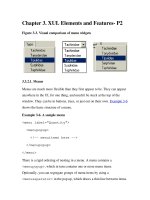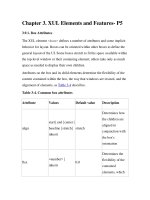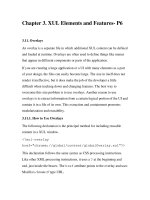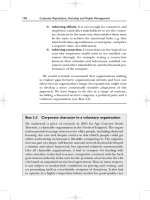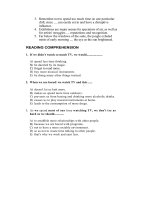elements and compounds lessons 1-3
Bạn đang xem bản rút gọn của tài liệu. Xem và tải ngay bản đầy đủ của tài liệu tại đây (12.23 MB, 31 trang )
Elements and Elements and
CompoundsCompounds
Lessons 1–3Lessons 1–3
CXECA08ARD501_LLR_CVa_03 3CXECA08ARD501_LLR_CVa_03 3 2/21/06 3:59:17 PM2/21/06 3:59:17 PM
Copyright © by Harcourt, Inc.
All rights reserved. No part of this publication may be reproduced or transmitted in
any form or by any means, electronic or mechanical, including photocopy, recording,
or any information storage and retrieval system, without permission in writing from the
publisher.
Requests for permission to make copies of any part of the work should be addressed to
School Permissions and Copyrights, Harcourt, Inc., 6277 Sea Harbor Drive, Orlando,
Florida 32887-6777. Fax: 407-345-2418.
HARCOURT and the Harcourt Logo are trademarks of Harcourt, Inc., registered in the
United States of America and/or other jurisdictions.
Printed in the United States of America
ISBN-13: 978-0-15-349188-7
ISBN-10: 0-15-349188-4
1 2 3 4 5 6 7 8 9 10 179 15 14 13 12 11 10 09 08 07 06
If you have received these materials as examination copies free of charge, Harcourt
School Publishers retains title to the materials and they may not be resold. Resale of
examination copies is strictly prohibited and is illegal.
Possession of this publication in print format does not entitle users to convert this
publication, or any portion of it, into electronic format.
CXECA08ARD501_LLR_CV2 4CXECA08ARD501_LLR_CV2 4 2/20/06 4:17:10 PM2/20/06 4:17:10 PM
Visit The Learning Site!
www.harcourtschool.com
Orlando
Austin
New York
San Diego
To r onto
London
Lesson 1
What Are Atoms and Elements? . . . . . . . . . . . . . . . . . . . 2
Lesson 2
What Are Metals?. . . . . . . . . . . . . . . . . . . . . . . . . . . . . . 10
Lesson 3
What are the Properties of Some
Common Substances?. . . . . . . . . . . . . . . . . . . . . . . . . . . 18
Elements and
Compounds
Lessons 1–3
1
CXECA08ARD5011-3_BLR_01 1CXECA08ARD5011-3_BLR_01 1 2/25/06 8:56:53 AM2/25/06 8:56:53 AM
VOCABULARY
element
atom
periodic table
compound
molecule
physical property
mixture
1
1
These gold bars have only
one kind of element in them.
What Are What Are
Atoms and Atoms and
Elements?Elements?
2
An atom is a very small unit
of matter.
Scientists use the periodic
table. It tells them a lot about
the elements.
CXECA08ARD5011-3_BLR.indd 2CXECA08ARD5011-3_BLR.indd 2 10/6/06 8:57:49 AM10/6/06 8:57:49 AM
Atoms of different elements
join to make a molecule.
These compounds are made
from different elements.
3
This salad is made from a
mixture of different fruits.
The shape of this lizard is a
physical property.
CXECA08ARD5011-3_BLR_01 3CXECA08ARD5011-3_BLR_01 3 2/24/06 6:56:05 PM2/24/06 6:56:05 PM
4
READING FOCUS SKILL
MAIN IDEA AND DETAILS
The main idea is what the text is mostly about.
Details tell more about the main idea.
The main idea is that all matter is made from
elements. Look for
details about how elements are
combined into mixtures and compounds.
Atoms and Elements
An
atom
is the smallest unit of an element. It is the smallest
part that has that element’s properties. An element is the
simplest form of matter. It has only one kind of atom. Oxygen
is an element. Oxygen is made only of oxygen atoms.
Atoms can be broken down into smaller parts. Atoms are
made of protons, neutrons, and electrons. All protons are
alike. All neutrons are alike. All electrons are alike. They do not
have properties of any element.
This oxygen atom
has 8 protons and
8 neutrons.
CXECA08ARD5011-3_BLR.indd 4CXECA08ARD5011-3_BLR.indd 4 2/20/06 4:39:35 PM2/20/06 4:39:35 PM
5
The lead of a pencil is made of
graphite. This is a soft form of carbon. C
The ways protons, neutrons, and electrons combine
form an element’s properties. They combine in different
amounts in each element. Each element has a different
number of protons. The number of protons tells scientists
which element it is.
Atoms have the properties of the element they are part of.
Carbon atoms have the properties of carbon.
There are about 100 elements. But only a few are found in
their pure states. Scientists give each element a short name.
They use one to three letters to name each element. Carbon
is C. Sodium is Na.
What makes an element different from
other elements?
D A diamond is made of
almost pure carbon.
All living things have
carbon in them. C
CXECA08ARD5011-3_BLR_01 5CXECA08ARD5011-3_BLR_01 5 2/24/06 6:56:08 PM2/24/06 6:56:08 PM
6
The Periodic Table
Elements are the building blocks of matter. From only about
100 elements, millions of things are made. Everything on Earth
is made from different groups of elements.
Atoms of each element have a certain number of protons.
Each atom of hydrogen has just one proton. Each atom of iron
has 26 protons. The number of protons in an atom is called its
atomic number.
Scientists use a chart called the
periodic table
. In this chart,
the atomic numbers of all elements are shown. Each element
has its own box in the table. In that box is the atomic number
of the element. Also in the box are the element’s name and
symbol.
How many elements are in the periodic table?
The Periodic Table
CXECA08ARD5011-3_BLR_01 6CXECA08ARD5011-3_BLR_01 6 2/24/06 6:56:23 PM2/24/06 6:56:23 PM
7
Water is made of 2
hydrogen atoms and
1 oxygen atom.
Molecules and Compounds
Most elements are seen as parts of compounds. A
compound
is a substance made of two or more elements. The
elements have been joined chemically. A formula tells what is
in a compound. It shows how many atoms of each element
are in the compound.
H
2
O is the symbol for the compound water. Water is made
of hydrogen and oxygen atoms. Both of these are elements.
The smallest piece of the compound water is a water
molecule. A
molecule
is the smallest unit of a compound.
What elements make up a water molecule?
CXECA08ARD5011-3_BLR.indd 7CXECA08ARD5011-3_BLR.indd 7 2/20/06 4:39:56 PM2/20/06 4:39:56 PM
Physical Properties
Physical properties
describe a substance. They tell what
a substance is like by itself. Water is wet. Wood is hard. These
are physical properties.
Some physical properites cannot be seen directly.
Temperature is a physical property. But you cannot see it. Mass
is a physical property. But you cannot see it. Both mass and
temperature have to be measured.
8
The element sodium (Na) is a metal. The
element chlorine (Cl) is a gas. They com-
bine chemically to make NaCl, or salt.
CXECA08ARD5011-3_BLR_01 8CXECA08ARD5011-3_BLR_01 8 2/24/06 6:56:28 PM2/24/06 6:56:28 PM
A
mixture
is a combination of two or more substances. In a
mixture, the substances themselves are not changed. Each part
of the mix could be separated out again.
Most materials found in nature are mixtures. Sand and air
are both mixtures.
In what form are most materials found in nature?
9
Complete this main idea statement.
1. ______ are the building blocks of matter.
Complete these detail statements.
2. Scientists use the ______ ______ to learn about
elements.
3. A ______ is the smallest unit in which an element
can exist.
4. In a ______ physical, but not chemical, changes
take place.
Review
Review
Nitrogen boils at very
low temperatures. That
is a physical property.
CXECA08ARD5011-3_BLR.indd 9CXECA08ARD5011-3_BLR.indd 9 2/20/06 4:40:33 PM2/20/06 4:40:33 PM
VOCABULARY
metal
nonmetal
malleable
alloy
metalloid
Metal is used to build things
that need to last a long time.
This lump of coal is made of
carbon, a nonmetal.
What Are What Are
Metals?Metals?
10
2
2
CXECA08ARD5011-3_BLR.indd 10CXECA08ARD5011-3_BLR.indd 10 2/20/06 4:40:39 PM2/20/06 4:40:39 PM
This statue is made of bronze.
Bronze is a metal alloy.
The aluminum in this can is
very malleable.
11
Computer chips are made from
silicon, a metalloid.
CXECA08ARD5011-3_BLR.indd 11CXECA08ARD5011-3_BLR.indd 11 2/20/06 4:40:52 PM2/20/06 4:40:52 PM
12
READING FOCUS SKILL
MAIN IDEA AND DETAILS
The main idea is what the text is mostly about.
Details tell more about the main idea
The main idea is that metals and nonmetals have
different properties. Look for more
details about the
properties of metals and nonmetals.
Metals and Nonmetals
A
metal
is a substance that easily conducts heat and
electricity. This means that metals heat up quickly. Electricity
passes through them easily.
About 75% of all elements are metals.
Copper is used for wires.
This is because it is a good
conductor of electricity. B
Copper is a metal.
CXECA08ARD501_1-3_BLR_12 12CXECA08ARD501_1-3_BLR_12 12 2/21/06 2:53:43 PM2/21/06 2:53:43 PM
13
Metals are
malleable
. They can be hammered or rolled into
thin sheets. They can be made into different shapes.
Carbon is a
nonmetal
. Nonmetals do not have the
properties of metals. Nonmetals do not conduct electricity
well. They do not conduct heat well.
How are metals different than nonmetals?
Mercury is a
metal. It remains
a liquid at room
temperature.
CXECA08ARD5011-3_BLR_13 13CXECA08ARD5011-3_BLR_13 13 2/24/06 6:58:09 PM2/24/06 6:58:09 PM
14
Properties of Metals
Elements in columns in the periodic table are alike. For
example, some metals conduct heat better than others.
Some metals are much less dense than others. Aluminum
and titanium are two such metals. They are very light. They
are used to make airplanes and other things that need to be
light.
What are two physical properties of metals?
Iron is a good conductor of
heat. It is often used to make
cooking pans.
CXECA08ARD5011-3_BLR.indd 14CXECA08ARD5011-3_BLR.indd 14 10/6/06 8:57:55 AM10/6/06 8:57:55 AM
Seeing Metal Atoms
Atoms are very small! Scientists must magnify atoms in order
to see them. They use special microscopes.
Most microscopes magnify things about 1,000 times. An
electron microscope can magnify more than 50,000 times.
Scientists can see very tiny objects, like cells. Another powerful
microscope is called a scanning tunneling microscope, or STM.
This microscope lets scientists look at atoms a different way. It
makes images based on how electrons move. The atoms in a
solids are arranged in set patterns. This is called an array.
Scientists can now use an STM to move single atoms to the
surface of a metal. They hope someday to make new materials
this way.
How does seeing atoms help scientists?
D This scientist is using
an electron micro-
scope. Images are
viewed on a screen.
15
CXECA08ARD5011-3_BLR.indd 15CXECA08ARD5011-3_BLR.indd 15 2/20/06 4:41:21 PM2/20/06 4:41:21 PM
A This bell is made of brass. It
does not corrode easily.
Alloys and Metalloids
Steel is an
alloy
. An alloy is a solid solution. One way
to make an alloy is to combine metals. Another way is to
combine a metal and a nonmetal. An alloy has properties
different from the materials in it.
Iron is the main metal in many steel alloys. But iron is not
very hard. It becomes harder when carbon is added to make
steel.
Bronze is an alloy made from mixing copper and tin. Bronze
is harder and stronger than copper. Many large statues are
made of bronze. They can stay outside for a long time and not
corrode, or break down.
16
CXECA08ARD5011-3_BLR_13 16CXECA08ARD5011-3_BLR_13 16 2/24/06 6:58:26 PM2/24/06 6:58:26 PM
Metalloids
are elements. They have some of the properties
of metals. They have some of the properties of nonmetals.
Silicon is a metalloid.
Silicon is less malleable than metal. It conducts electricity,
but not as well as copper. The flow of electricity can
be controlled in silicon. Metalloids like this are called
semiconductors. Semiconductors are used in computers and
CD players.
What is the main metal in many steel alloys?
17
Complete this main idea statement.
1. ______ is a substance that easily conducts
electricity and heat.
Complete these detail statements.
2. Metals are ______ . They can be hammered or
rolled into shapes.
3. An ______ is made from different metals, or a metal
and a nonmetal.
4. A ______ has properties of both metals and
nonmetals.
Review
Review
The elements used in
making steel alloys differ.
They are changed to make
an alloy better for the use
it will have.
CXECA08ARD5011-3_BLR.indd 17CXECA08ARD5011-3_BLR.indd 17 10/6/06 10:39:32 AM10/6/06 10:39:32 AM
VOCABULARY
gas
liquid
solid
These balloons are filled with
helium gas.
Skim milk is a liquid that is
healthful to drink.
What Are the What Are the
Properties Properties
of Some of Some
Common Common
Substances?Substances?
18
3
3
CXECA08ARD5011-3_BLR.indd 18CXECA08ARD5011-3_BLR.indd 18 2/20/06 4:42:15 PM2/20/06 4:42:15 PM
The sand in this sand castle is a
solid.
19
CXECA08ARD5011-3_BLR_19 19CXECA08ARD5011-3_BLR_19 19 2/27/06 3:14:38 PM2/27/06 3:14:38 PM
20
READING FOCUS SKILL
MAIN IDEA AND DETAILS
The main idea is what the text is mostly about.
Details tell more about the main idea.
The main idea is that many substances have similar
properites. Look for more
details about the properties of
common substances.
Common Gases
Air is invisible. Air is not an element or a compound. Air has
no chemical formula. It is a mixture of gases.
A
gas
is a state of matter. In a gas, matter has no definite
shape. It has no definite volume, or amount either.
Air is about 78% nitrogen (N
2
). Air also has about 21%
oxygen (O
2
) in it. Oxygen makes it possible for other
substances to burn. They burn when they mix with oxygen.
Oxygen
21%
Nitrogen
78%
Argon
0.93%
Carbon dioxide
about 0.035%
Other gases
about 0.035%
Gases in the Atmosphere
Oxygen
21%
Argon
0.93%
Carbon dioxide
about 0.035%
Other gases
about 0.035%
Nitrogen
78%
CXECA08ARD5011-3_BLR_13 20CXECA08ARD5011-3_BLR_13 20 2/24/06 6:58:34 PM2/24/06 6:58:34 PM
Another form of oxygen is ozone (O
3
). There is ozone
in Earth’s upper atmosphere. Ozone helps keep Earth at a
constant temperature.
Hydrogen is another gas. It is the most common element in
the universe.
Helium is a gas that is lighter than air. It is used in weather
balloons and blimps.
Another common gas is carbon dioxide (CO
2
). When you
breathe out, you exhale mostly carbon dioxide.
Why doesn’t air have a chemical formula?
21
This balloon is filled with helium.
Helium weighs less than air, so
the balloon floats. B
CXECA08ARD501_1-3_BLR_21 21CXECA08ARD501_1-3_BLR_21 21 2/21/06 3:14:27 PM2/21/06 3:14:27 PM
22
Common Liquids
A
liquid
is a state of matter. In this state, matter has a
definite volume. But it has no definite shape.
Water is the most common liquid on earth. The oceans
cover more than 70% of the earth. Ocean water is salt water.
Water is the only compound on Earth that can be found in
all three states. Water can be a liquid. It can be a gas (water
vapor). Or it can be a solid (ice).
These monkeys in a hot spring have ice on their heads.
Water is seen in all three states here. B
CXECA08ARD5011-3_BLR.indd 22CXECA08ARD5011-3_BLR.indd 22 2/20/06 4:42:43 PM2/20/06 4:42:43 PM
23
Mercury was used
in thermometers
for many years.
When most liquids are cooled, their particles get closer
together. They contract, or take up less space. Water contracts
until it reaches about 4 degrees centigrade (39° F). As it cools
further, it expands, or takes up more space.
As water molecules change into ice, they form rings. The
rings take up more space. That is why ice takes up more space
than water.
Mercury is the only metallic element that is
liquid at normal temperatures. It was used in
thermometers. But mercury is poisonous, so
it is not used any more. Alcohol is used now.
What are some unusual properties
of water?
CXECA08ARD5011-3_BLR.indd 23CXECA08ARD5011-3_BLR.indd 23 2/25/06 12:35:39 PM2/25/06 12:35:39 PM
